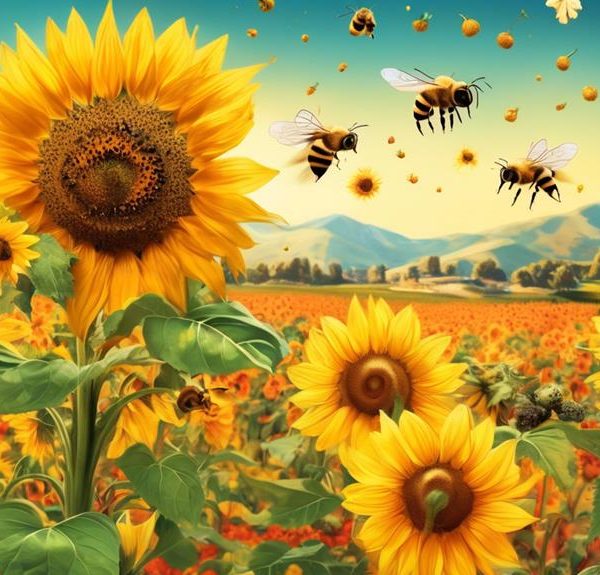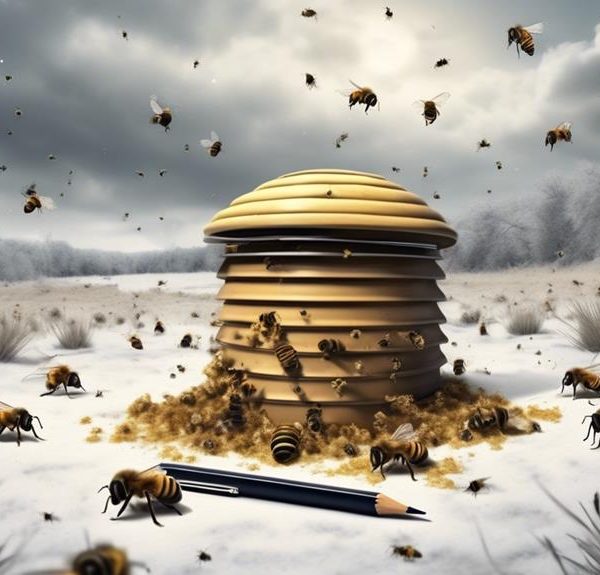Gain a deeper understanding of how bees, our vital pollinators, contribute to the ecosystem and our food supply in this enlightening discussion.
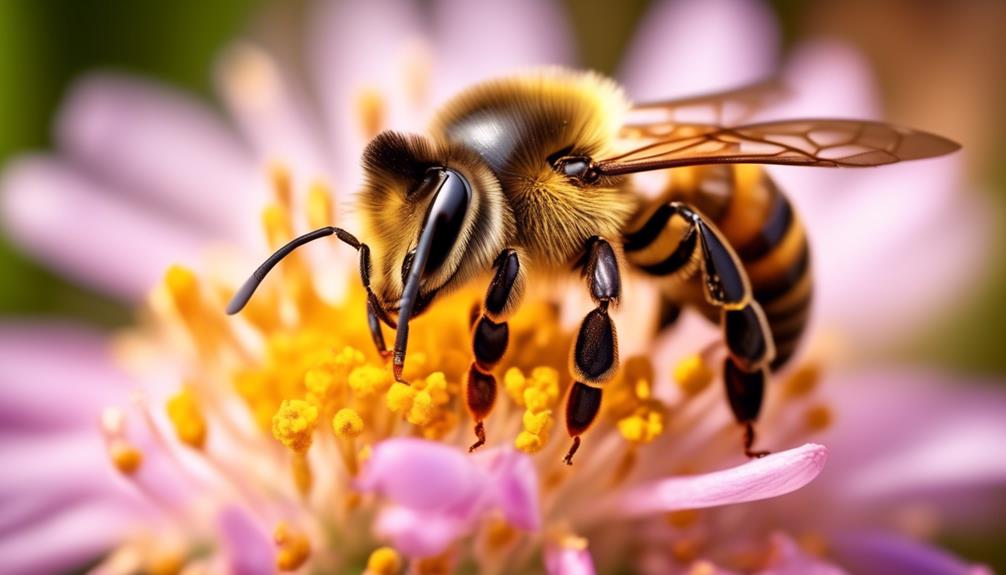
How and Why Do Bees Pollinate?
Busy bees buzzing beyond your back garden are more than just a pretty sight, they're vital pollinators playing a paramount role in the ecosystem and our food supply.
You might wonder, how and why do these little creatures carry out this intricate task? Well, it's all down to their biology and the survival of their species.
But it's not just about the bees, it's about us too. As we move further into this discussion, you'll uncover the fascinating relationship between these industrious insects and the environment, which might just leave you seeing bees in a whole new light.
Key Takeaways
- Bees have specialized structures and behaviors that enable them to collect and transfer pollen, promoting cross-pollination.
- Bees are essential for maintaining biodiversity by pollinating a majority of wild flowering plants and supporting a variety of animals and insects.
- Bees play a vital role in the food chain by pollinating crops that make up a significant portion of the world's food supply.
- Bee populations are declining due to habitat loss, pesticide exposure, climate change, and other factors, posing a threat to food security and ecosystem balance.
Understanding the Bee Anatomy
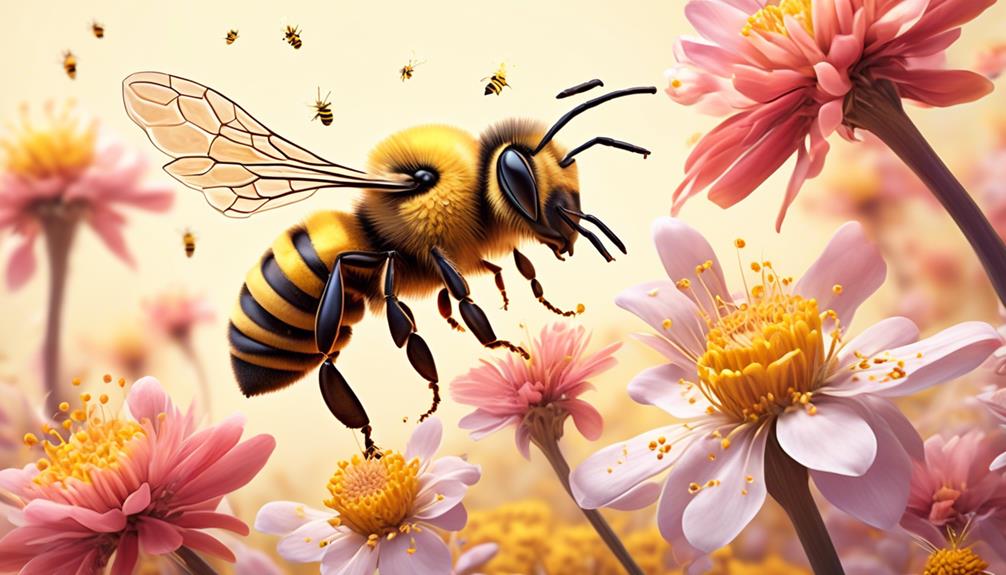
To grasp the intricate process of bee pollination, it's crucial to first dissect the fascinating anatomy of these industrious insects.
Bees are equipped with a complex morphology that's specifically designed for their roles as nature's prime pollinators.
You'd observe that the body of a bee, like other insects, consists of three main parts: the head, the thorax, and the abdomen. Each of these parts plays a unique role in the pollination process.
The head houses the bee's compound eyes and antennae, which are essential for locating flowers.
The thorax, on the other hand, is where you'll find the bee's wings and legs. These legs are particularly interesting because they possess specialized hairs and structures for collecting pollen.
And then there's the abdomen, which is responsible for the storage and transport of nectar. Inside, there's a nectar pouch and a specialized organ called a sting gland. The nectar pouch can hold a considerable amount of nectar collected from flowers, while the sting gland produces venom to protect the bee.
In essence, the bee's anatomy isn't just intricate; it's a marvel of biological engineering that enables this tiny creature to play such a vital role in our ecosystem.
The Pollination Process Explained
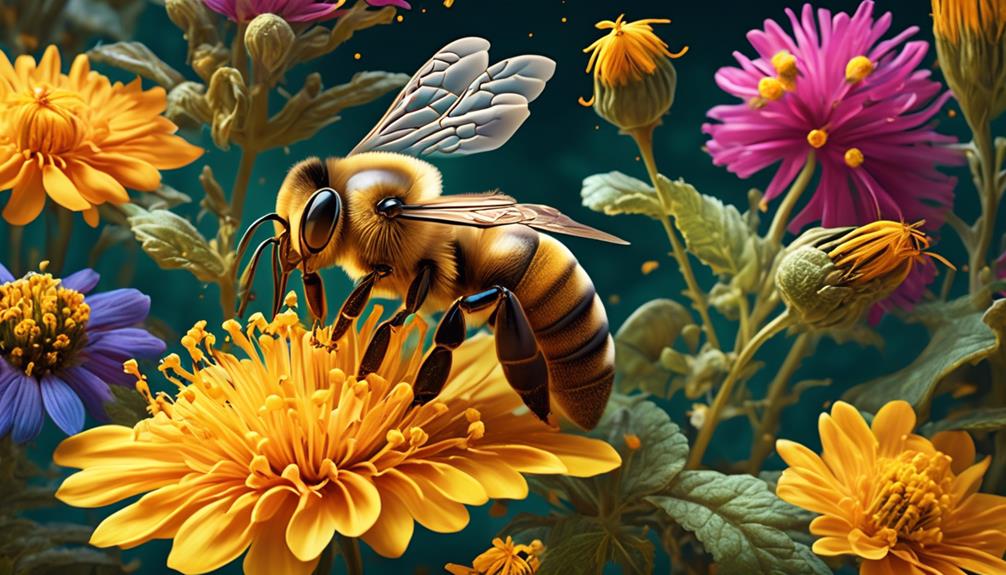
Often, you'll find bees diligently working, buzzing from flower to flower, engaging in an intricate dance that's not merely a food hunt, but an essential pollination process critical for plant reproduction. You see, bees are key players in this process, and it starts when they land on a flower in search of nectar. As they move into the flower's center, they inadvertently brush against the stamen, the male reproductive organ of the flower, and pollen grains stick to their hairy bodies.
When the bee visits the next flower, some of this pollen rubs off onto the female reproductive part, the pistil, specifically on the sticky stigma. This cross-pollination allows for genetic diversity among plants, promoting their survival. It's a sophisticated symbiotic relationship – while bees get their food, they also aid in plant reproduction.
Furthermore, bees aren't just accidental pollinators. They're biologically equipped for this job. The bee's body has evolved to carry pollen efficiently, with specialized structures like pollen baskets on their hind legs. Thus, bees are nature's prime pollinators, facilitating a process that's critical for the world's biodiversity.
Importance of Bees in Ecosystem
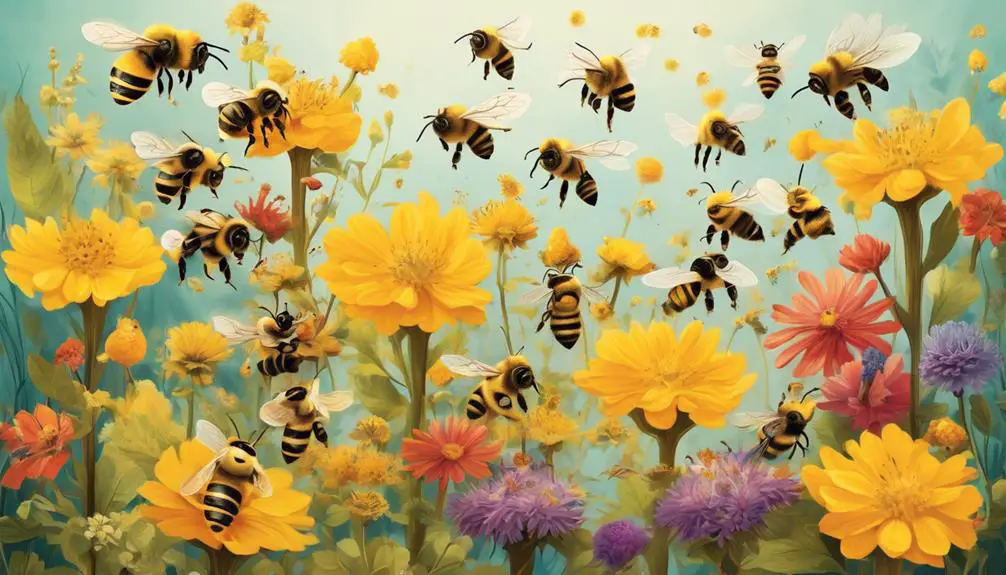
While you've understood how bees play a crucial role in pollination, it's equally crucial to comprehend their broader impact on the ecosystem as a whole. Bees, in fact, are key to maintaining biodiversity. They help in the reproduction of over 85% of wild flowering plants, serving as essential pollinators. This contributes to the diversity of plant species, which in turn supports a variety of animals and insects.
Moreover, bees are a vital part of the food chain. They pollinate a significant proportion of the crops that make up the world's food supply, meaning their absence could seriously affect your daily meals. To put it in perspective, imagine a world without fruits like apples, berries, or vegetables like cucumbers, pumpkins. The role bees play in food production is irreplaceable.
Further, bees play a role in carbon sequestration. By pollinating plants, they aid in plant growth, which in turn absorbs more CO2 from the atmosphere. So, you see, bees aren't just about honey. They're pivotal in preserving the balance of our ecosystem, supporting food security, and combating climate change.
Impact on Human Food Supply
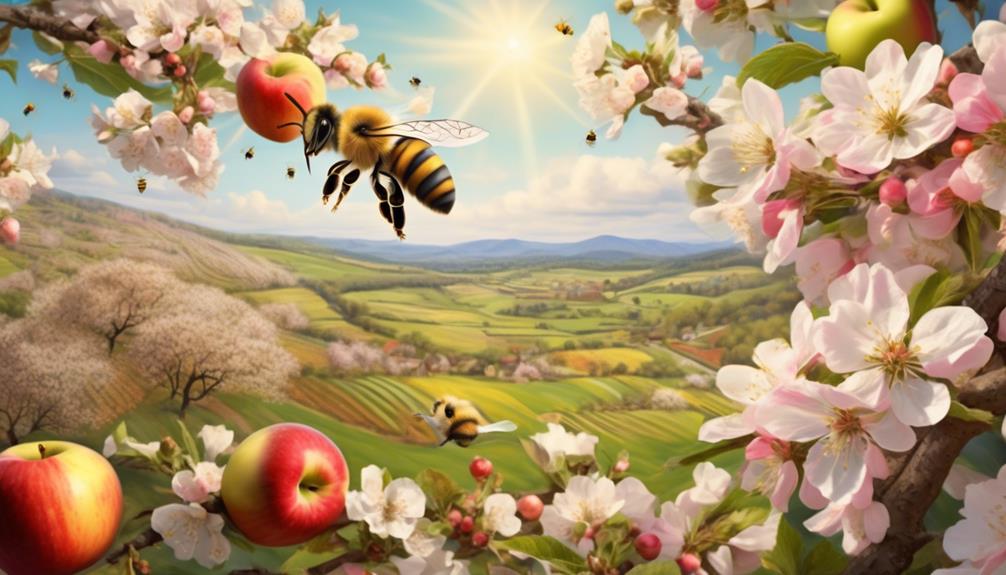
Remarkably, nearly one-third of our global food supply relies directly on bee pollination, underscoring their critical role in sustaining agricultural systems. Many of the foods you consume daily, such as fruits, vegetables, nuts, and even coffee, depend on bees. Without their diligent work, you'd see a drastic drop in the diversity and availability of foods.
Bees help plants produce fruit by transferring pollen from the male parts of a flower to the female parts. This process, known as pollination, is essential for plant reproduction. In fact, it's estimated that 70% of the top 100 crop species, which provide 90% of the world's food, are pollinated by bees. Imagine your grocery store without apples, almonds, cucumbers, or even chocolate. That's the reality we'd face without bees.
Sadly, bee populations are declining worldwide due to habitat loss, pesticide exposure, and climate change. This is a serious concern as it could disrupt our food supply chain. Therefore, it's vital to conserve bee populations and their habitats. Your actions can help. Whether it's planting bee-friendly flowers or reducing pesticide use, every effort counts in preserving these tireless pollinators and our food supply.
Threats to Bee Populations
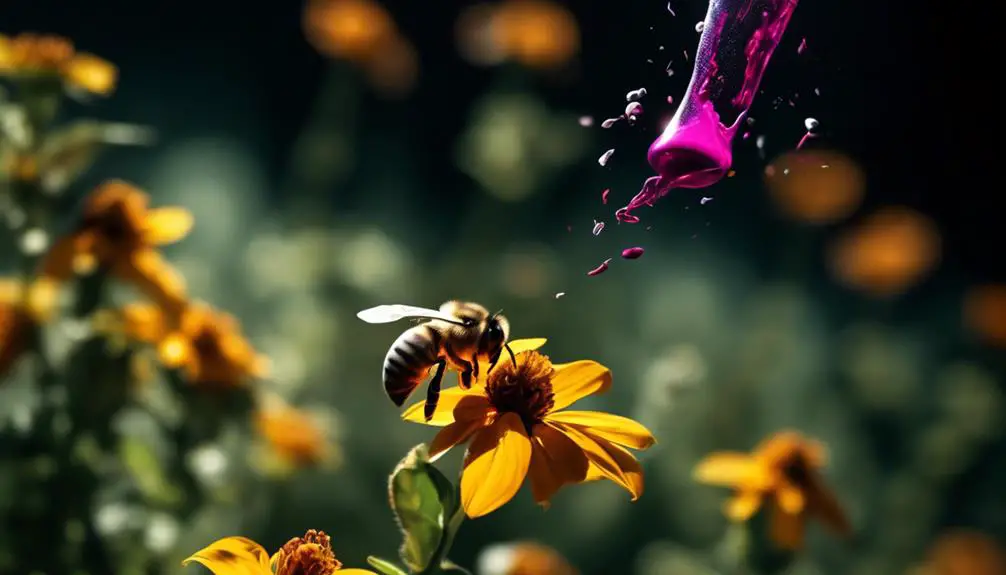
Despite their critical importance, bees are facing numerous threats that are causing their populations to plummet globally.
One of the main culprits is habitat loss. As humans continue to expand urban areas, bees are losing their natural habitats and food sources.
Pesticides, particularly neonicotinoids, also pose a significant threat. They're neuroactive, affecting the bees' central nervous system, leading to disorientation and weakened immune systems.
Climate change is another serious threat. As weather patterns shift, flowers bloom at different times, disrupting the bees' pollination schedule.
Invasive species, like the Varroa mite, devastate bee colonies, spreading viruses and diseases.
Interestingly, beekeeping practices contribute to the problem as well. Monoculture, the practice of growing a single crop over a large area, limits the bees' diet, weakening their health.
Furthermore, commercial beekeepers often transport bees large distances for pollination services, causing stress and increasing disease transmission.
Frequently Asked Questions
What Other Insects or Animals Are Involved in the Pollination Process?"
Besides bees, you'll find a wide variety of creatures playing a part in pollination. Butterflies, moths, beetles, and even some birds and bats get involved.
They're attracted to the flowers for their nectar and in the process, they transfer pollen from the male parts of a flower to the female parts.
It's not just a bee's game, pollination is a vital task carried out by many members of the animal kingdom.
How Do Bees Communicate With Each Other About the Location of Flowers?"
Bees communicate about flower locations through a 'waggle dance.'
Imagine this: You're a bee, you've found a rich source of nectar. You return to the hive and perform a figure-eight dance.
The direction you dance in relates to the sun's position, showing the other bees where to find the flowers.
The speed of your dance indicates the distance.
It's a complex, yet remarkably effective form of communication among these tiny creatures.
What Differentiates Bees From Other Pollinators?"
You're wondering what sets bees apart from other pollinators. Well, bees are unique because they're specialized for pollination.
Unlike most pollinators, they've fuzzy bodies that catch pollen effectively, and they've adapted to carry it in 'pollen baskets'.
Plus, bees need pollen to feed their young, making them more motivated to jump from flower to flower. Other pollinators don't rely on pollen as a food source which makes bees more efficient in pollination.
What Are the Primary Reasons for Colony Collapse Disorder?"
You've asked about the primary reasons for colony collapse disorder (CCD). It's a complex problem, but we know it's often tied to pests like the Varroa mite, harmful pesticides, and poor nutrition due to habitat loss.
There's also stress from commercial beekeeping practices. It's not a single issue, but a combination that weakens the bees' health, making them more susceptible to disease.
These factors together contribute to the alarming rates of CCD.
How Can Individuals Contribute to Bee Conservation Efforts?"
You can contribute to bee conservation efforts in several ways.
Start by planting native flowers in your yard to provide food for bees.
Limit or avoid pesticide use as it's harmful to them.
Setting up a bee house also encourages bee population growth.
Importantly, support local beekeepers by buying local honey, which in turn supports the local bee population.
Lastly, spreading awareness about the importance of bees helps others join the conservation efforts.
Conclusion
You've seen how crucial bees are to our ecosystem. They're not just buzzing around aimlessly; they're hard at work pollinating and ensuring our food supply.
But with their populations under threat, it's clear we need to step up to protect them. After all, without bees, our food chain could collapse.
So, let's not underestimate their worth – we depend on these tiny pollinators more than we often realize.

